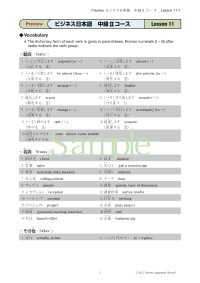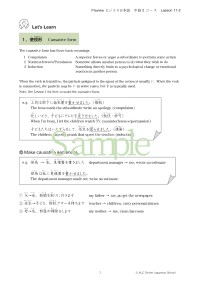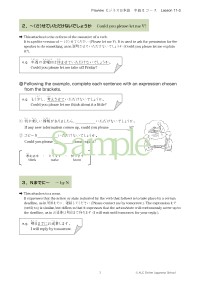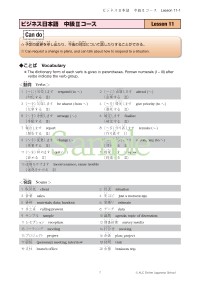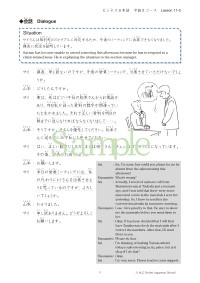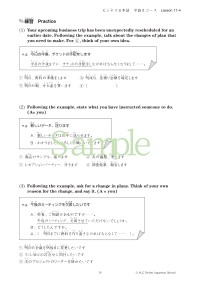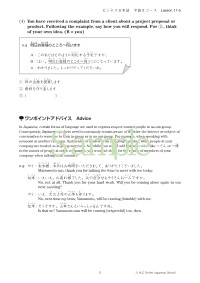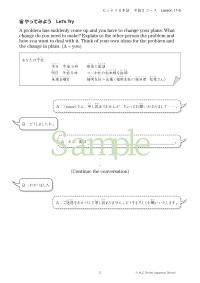About the courses
- Home
- Course List
- Business Japanese Intermediate Course Ⅱ
Business Japanese Intermediate Course Ⅱ
- Level of lesson
- Intermediate
- Japanese Language Proficiency Test N3-2 equivalent
- Course consists of twenty 50-minute lessons
This course is targeted at learners who have acquired conversational skills at the early intermediate level. It is designed to help them communicate at a slightly advanced level where they are able to match their use of honorifics and expressions to the situation or listener. It teaches patterns and expressions used in everyday interactions with coworkers and in business-related exchanges with people inside and outside one's company. The aim is to enable learners to more smoothly perform their jobs through effective use of Japanese.
| Lessons | Topics | Objectives |
|---|---|---|
| 1 | Talking about how people have helped you | Can look back at the past and talk about things you did or help you received. |
| 2 | Talking about physical condition and health | Can talk about health problems, and share ideas for improving them. |
| 3 | Asking about things you don’t understand at work | Can ask a busy coworker about something you don’t understand. |
| 4 | Giving advice for solving concerns | Can ask someone to perform a task, can provide advice in response to a question, and can communicate an objective and the instructions for accomplishing it. |
| 5 | Review 1 | Review Sessions 1–4 to improve fluency in the expressions learned. |
| 6 | Speaking politely to people from outside your company | Can express respect and gratitude toward customers and other people outside your company when speaking with coworkers. |
| 7 | Talking about tricks and methods to keep up a practice | Can talk about hard work or tricks for keeping up a certain activity. |
| 8 | Ascertaining the situation behind problems, and suggesting solutions | Can understand the situation when someone comes to you for advice, and can suggest solutions. |
| 9 | Speaking politely to people from within and outside your company | Can communicate with people from within and outside your company, including being able to speak politely and express gratitude. |
| 10 | Review 2 | Review Sessions 5–9 to improve fluency in the expressions learned. |
| 11 | Requesting a change of plans | Can request a change in plans, and can talk about how to respond to a situation. |
| 12 | Talking about things that have caught your attention | Can talk about things around you that have aroused your curiosity, and can gather information about them. |
| 13 | Requesting coworkers to perform tasks | Can ask a coworker to perform a task, and can explain what needs to be done. |
| 14 | Responding to inquiries at work | Can answer and respond to inquiries from coworkers and clients. |
| 15 | Review 3 | Review Sessions 11–14 to improve fluency in the expressions learned. |
| 16 | Talking about preparing for disasters | Can talk about how to prepare for disasters. |
| 17 | Talking about difficult experiences at work | Can talk about difficult experiences at work and empathize with other people. |
| 18 | Seeking advice on or explaining how to solve problems | Can explain the situation to others around you when a problem occurs, and can seek their advice to solve it. |
| 19 | Talking about memories | Can talk about news concerning someone who was of great assistance to you, and can talk about memories of that person. |
| 20 | Review 4 | Review Sessions 16–19 to improve fluency in the expressions learned. |
*Lesson content and order may change.
Teaching materials and lesson formats
Each lesson provides learning materials “Preview” for preparing for and taking the lesson. Each preparatory learning material explains the vocabulary and grammar required in the lesson. Learning materials for taking lessons contain many conversation examples so that students can practice conversation fully with course instructors.
The 20 lessons include four review lessons: check your Japanese proficiency while continuing to learn.



